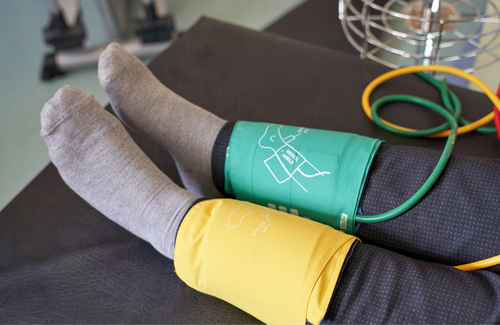Peripheral artery disease, one of the most common forms of cardiovascular disease, occurs more frequently in people with HIV who have CD4 cell counts below 500, regardless of whether they smoke or have other risk factors for cardiovascular disease, an analysis of the large US Veterans Aging Cohort Study has shown.
The findings were presented by Matthew Freiberg of Vanderbilt University Medical Center, Nashville, at the 9th International AIDS Society Conference on HIV Science (IAS 2017) in Paris last month.
Peripheral artery disease: background
Peripheral artery disease is the second most common form of cardiovascular disease after coronary artery disease. Arteries in the lower limbs or supplying major organs become narrowed as a result of deposits of cholesterol. Blood supply to the limbs is reduced, leading to cramping or pain in the leg and hip muscles during activity. As peripheral artery disease progresses, pain may become more persistent. In its most advanced form, peripheral artery disease can lead to tissue damage and gangrene in the limbs, possibly requiring amputation.
Numbness in the limbs, sores on the legs or feet, pale or blue skin on the legs or hair loss on the legs and feet are also symptoms of peripheral artery disease. The condition is more common in men and may progress for a long time without symptoms. Peripheral artery disease can be diagnosed by comparing the blood pressure at the ankle and the arm; lower blood pressure at the ankle, caused by a restricted blood supply, indicates peripheral artery disease.
People who develop peripheral artery disease are at high risk for a stroke or heart attack. Peripheral artery disease is already present in around one in twenty people in the 45-50 age group and the risk increases with age and in people with other risk factors for cardiovascular disease, especially smoking or diabetes.
Stopping smoking and taking regular exercise can improve the condition, as can reduction of cholesterol, blood sugar and blood pressure through lifestyle and dietary changes and medication.
Peripheral artery disease in the Veterans Aging Cohort Study
To determine whether HIV infection is a risk factor for peripheral artery disease, researchers from the Veterans Aging Cohort Study (VACS) looked at the incidence of peripheral artery disease in over 90,000 participants in VACS from January 2003 to September 2012. VACS consists of US military veterans receiving care through the Veterans Health Administration; it follows the health of people living with HIV with a control group of HIV-negative people matched by age, race and sex.
This analysis included 29,291 people with HIV and 62,996 controls. Approximately 97% were male, the median age was 48 years, 48% of participants were African American, 38% were white and 7% were Hispanic. Risk factors for cardiovascular disease were common in both groups; 50% of people with HIV and 63% of HIV-negative controls had hypertension, 9% of people with HIV and 13% of the control group had diabetes and over half of each group smoked (56% and 50%).
In the HIV-positive population, the median CD4 cell count was 383 cells/mm3 at baseline and 56% were not taking antiretroviral treatment at the beginning of the follow-up period.
After adjusting for age, sex, race and cardiovascular risk factors including LDL cholesterol, triglycerides, diabetes, smoking, hypertension, obesity, impaired kidney function, hepatitis C infection, and alcohol or cocaine abuse, the investigators found an increased risk of peripheral artery disease in people with HIV with CD4 cell counts below 500 cells/mm3.
The risk of peripheral artery disease was 24% higher in people with CD4 counts in the range 200-499 cells/mm3 (hazard ratio 1.24, 95% CI 1.14-1.35, p < 0.001) and 73% higher in people with CD4 cell counts below 200 cells/mm3 (HR 1.72, 95% CI 1.53-1.91, p < 0.001) when compared to HIV-negative people but was not significantly higher than the control group in people with HIV who had CD4 cell counts above 500 cells/mm3. In this analysis the risk of peripheral artery disease was calculated using the most recent CD4 measurement prior to the diagnosis of peripheral artery disease.
The relationship between lower CD4 cell count and increased risk of peripheral artery disease persisted after adjusting for the absence of detectable viral load (which would indicate the use of effective antiretroviral treatment).
If people developed peripheral artery disease, their subsequent survival was strongly associated with their CD4 cell count at the time of diagnosis of peripheral artery disease. Four years after diagnosis, less than half of people with a CD4 cell count below 200 cells/mm3 at the time of diagnosis of peripheral artery disease were still alive compared to around three-quarters of those with CD4 cell counts above 500 at the time of their diagnosis.
The authors concluded that among a population of HIV-positive military veterans with a high prevalence of risk factors for cardiovascular disease, immunodeficiency – a CD4 cell count below 500 cells/mm3 – or a detectable viral load each raised the risk of developing peripheral artery disease and of dying after a diagnosis of peripheral artery disease.
Freiberg M et al. HIV infection and the risk of peripheral arterial disease. 9th International AIDS Society Conference on HIV Science, Paris, 23-26 July, 2017, abstract WeAB0102.
View the abstract on the conference website.
Download the presentation slides from the conference website.
Watch the webcast of this session on YouTube.
Update: Following the conference presentation, this study was published in a peer-reviewed journal:
Beckman J et al. Association of Human Immunodeficiency Virus Infection and Risk of Peripheral Artery Disease. Circulation, 138:255-265, July 2018.

